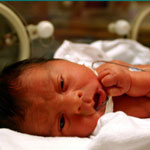Human Error Most Common Cause of Birth Asphyxia, According to Norwegian Study
 Human error is the most common cause of birth asphyxia (an inadequate supply of oxygen) at birth. That’s the finding of a 15-year study published in Acta Obstetricia et Gynecologica Scandinavica, a journal of the Nordic Federation of Societies of Obstetrics and Gynecology.
Human error is the most common cause of birth asphyxia (an inadequate supply of oxygen) at birth. That’s the finding of a 15-year study published in Acta Obstetricia et Gynecologica Scandinavica, a journal of the Nordic Federation of Societies of Obstetrics and Gynecology.
Inadequate fetal monitoring, lack of clinical skills and failure to obtain senior medical staff assistance were the most frequent birth injury malpractice related causes of birth asphyxia claims made to the Norwegian System of Compensation to Patients (NPE).
Injuries due to birth asphyxia
Low oxygen levels may decrease a baby’s blood pressure, heart rate and blood flow from the heart. This can limit the blood flow to tissues and organs, causing improper cell function or damage. Organs normally impacted by lowered oxygen levels include the brain, heart and blood vessels, lungs, kidneys and gastrointestinal tract.
“While fetal brain injury or death is uncommon during childbirth, when it occurs the effects are devastating,” states Dr. Stine Andreasen of the Department of Obstetrics and Gynecology at Nordlandssykehuset (Nordland Hospital) in Bodø, Norway. “In most compensated cases, poor fetal monitoring led to an inadequate supply of oxygen to the infant,” explains Dr. Andreasen. “Training for midwives and obstetricians, along with high-quality audits, could help to reduce claims for compensation after birth asphyxia.”
Norwegian birth injury malpractice claims
Researchers examined 315 NPE birth asphyxia related claims between 1994 and 2008. The team reviewed hospital records, assessments by experts, NPE records and decisions by courts of law. Of the 315 claims, 161 cases received compensation. Of those compensated cases 107 infants survived, 96 had neurological injuries and 54 infants died.
Human error was the most frequent cause of birth asphyxia, with 50% of the cases linked to inadequate fetal monitoring, 14% due to lack of clinical knowledge, 11% caused by failing to comply with clinical guidelines, 10% of the cases were linked to a failure to ask for senior medical assistance and 4% were caused by errors in drug administration. In cases of substandard care, the obstetrician was documented as the responsible party 49% of the time and the midwife was cited as being responsible in 46% of the cases.
There are roughly 60,000 births each year in Norway. The NPE receives about 65 claims for obstetric injury to children each year. A prior study found that asphyxia was the most common cause for compensation due to obstetric injury to children, between 20 and 25 cases annually. Lifelong compensation for injury due birth asphyxia averages about €430,000 ($574,000) in Norway, according to a previous study.
Other possible causes of birth asphyxia
- Inadequate oxygen levels in the mother’s blood. This can be caused by to heart or respiratory problems or lowered respirations caused by anesthesia,
- Low maternal blood pressure,
- Lack of oxygen circulation to the placenta caused be inadequate relaxation of the uterus during labor,
- Placental abruption or early separation of the placenta from the uterus,
- Decreased blood flow to the fetus due to compression of the umbilical cord, and
- Poor placenta function that may be caused by high blood pressure or in post-term pregnancies, particularly those past 42 weeks.
Prompt treatment after birth may minimize the harm due to decreased oxygen to the baby.


